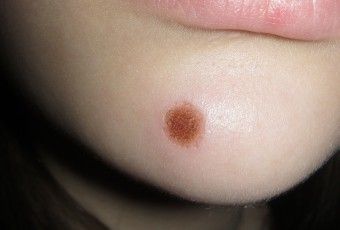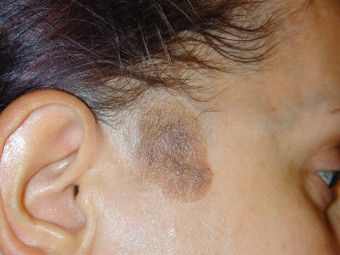Birthmarks are on the body of almost every person. All of them are different in color, appearance and type, can be located in the most unforeseen places. Some people, until a certain point, do not even realize that they have birthmarks.
Where do they come from?

In most cases, a person is born with them, but sometimes they appear or appear more clearly already in adulthood.
Despite their apparent harmlessness, these darkening or redness of the skin can create some discomfort. In addition, there is always a danger that such a “mark” will begin to grow and “degenerate” into something that threatens health and life. Most of all the unpleasant sensations are delivered by a birthmark on the face, which there is no way to disguise.
What to do if such a “mark” on the face does not allow you to live calmly and fully, and is it possible to somehow get rid of it?
Views
This neoplasm is divided into and two types are divided: ordinary and vascular nevi.
Normal nevi are brown formations (from light to almost black) in most cases having a smooth surface. They can be flat or rise slightly above the surface of the skin, often have hairline.
A lot of people live quite calmly all their lives with birthmarks that do not cause any physical discomfort. However, you should not leave them unattended, you need to observe them and, at the slightest change in their structure or color, seek medical advice.
Ordinary nevi do not need any treatment and removal, unless they are located in places of constant irritation and trauma due to the risk of infection and degeneration into melanoma.
Vascular “marks” are spots of red, burgundy or wine color, representing an accumulation of small blood vessels. Most often, bright red formations protrude somewhat above the surface of the skin, and wine formations are completely flat and indistinguishable to the touch..
They cannot develop into melanoma, just as ordinary brown neoplasms do not require treatment. However, they are trying to remove them in order to improve their appearance, especially if this large and noticeable birthmark is located on the face..
There are three types of vascular nevus:
- hemangioma – a vascular formation, a bright red birthmark most often on the face or head;
- “Wine birthmark” or “flaming” nevus;
- one large or many small salmon-colored birthmarks.
Wine stains consist of arachnid blood vessels in the skin, they are flat and indistinguishable to the touch. Such nevi grow along with human growth and never disappear on their own. Surgical removal is practically impossible, especially if the size of the nevus is large.

Closer to two years, the hemangioma begins to fade and gradually in color approaches the shade of ordinary skin, by six years it becomes almost invisible, and by nine it disappears without a trace. By their nature, such nevi are harmless, but since the neoplasm has appeared, it requires constant monitoring.
Salmon birthmarks are the most common type of nevus in newborns. They are usually located on the back of the head and neck, do not need treatment and pass on their own during the first year of life.
Delete
The scientific developments of biologists, physicists and doctors made it possible to treat many previously untreatable diseases, including birthmarks on the face, head, neck and other parts of the body..
Today, the dream of many people who have to live with such cosmetic defects can become a reality. To remove the usual birthmark on the face or other part of the body without any unpleasant consequences and residual cosmetic defects will help the latest technology in medicine – painless and low-traumatic laser operations.
Such treatment is carried out in specially created medical centers by highly qualified doctors using modern, reliable equipment..
The advantages of using this method, which is the most popular at present, include:
- painlessness and less trauma;
- high efficiency;
- selective action and small diameter of the laser beam;
- high accuracy of guidance, avoiding damage to adjacent areas;
- quick recovery after surgery;
- short duration of the operation itself;
- complete absence of bleeding.
The average rehabilitation period is 10 days. No strict restrictions are required at this time, it is only necessary to exclude sun exposure.
The main disadvantage of the laser technique is the inability to send a remote nevus to histology. Therefore, the use of this method is allowed only provided that the non-cancerous nature of the formation is confirmed by analysis.










